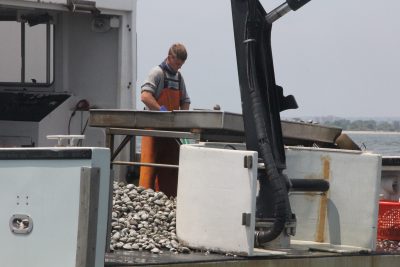Story and photos by Judy Benson

Now, as their normally slow winter season approaches, oyster growers like Dave Hopp, Steve Plant and Larry Fernandez are preparing to weather what could be even tougher months ahead, with fresh influxes of federal and state funding coming just when they’re going to be needing it most.
“We’ve got to get through this,” said Hopp of Bell’s Shellfish, a company he owns with his two grandsons that harvests oysters and clams from the waters of Long Island Sound offshore from Norwalk and Bridgeport.
For the first time this summer, Bell’s Shellfish and several other companies sold their oysters and clams directly to customers at outdoor markets and breweries. As colder temperatures descend, Hopp’s grandson Robert Norrholm is looking to do home deliveries of shellfish for the holidays.
“As of right now, we’re just keeping our heads above water,” he said. State and federal assistance they received has been critical.
Connecticut Cultured Oysters owner Steve Plant survived the near total loss of his restaurant sales by shucking and selling fresh oysters himself seven days a week at Ford’s Lobsters, a seasonal outdoor eatery next door to the Noank docks where he keeps his boats, along with income from his wife Jill’s farmers market sales. While Jill Plant can continue selling at the indoor winter farmers market, the end of the outdoor dining season has Steve Plant hoping the modest rebound of wholesale restaurant orders he’s been seeing will continue. But he’s keenly aware a further surge in COVID cases could shut indoor dining again.
“Nobody knows whether we’re going to find ourselves back in the same situation we were in last spring,” he said.
He already dipped into his savings and “tightened his belt” to get through the spring and summer. Now, he and other shellfishermen are awaiting financial assistance from new federal and state programs from the SBA, USDA, NOAA and Connecticut CARES small business grants.
“Those programs weren’t available during the worst of the crisis in the spring,” he said. “But they may be coming along now when it’ll be beneficial for us going into the winter.”
Tessa Getchis, aquaculture extension specialist for Connecticut Sea Grant, said that the state’s $30 million shellfish industry wouldn’t have been able to survive without the various state and federal assistance programs that many – but not all – shellfishermen have tapped so far. These ranged from the Paycheck Protection Program and others broadly available, to those that specifically targeting shellfish farmers. CT Sea Grant worked with the state Department of Agriculture Bureau of Aquaculture to facilitate direct market sales, make shellfishermen aware of financial assistance and identified innovative ways for the farmers to earn income while markets were closed.